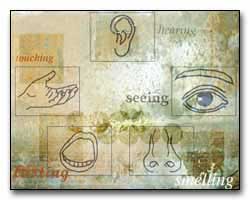|
 The Art Of Touching (T-Vision):
The Art Of Touching (T-Vision):
The term T-Vision is being used for the type of touch used in Outdoor Eyes since touch is directly related to seeing. When you close your eyes and walk across the ground to feel a pile of pine needles with your bare feet, you might picture tall white pine trees in a forest next to you. If you happen to pick up a pine cone, that will reinforce the vision of the white pines. And if you combine the touch with that distinct smell of a pine forest, that will convince you of where you are. So, as you can see, touch is definitely related to seeing.
Touch Is Not Dedicated To The Hands:
Don't confuse the terminology of T-Vision to be exclusively relates to your hands. Touch comes in many forms and consists of using all parts of your body. What does it feel like to stand outside and have the rain drench your entire body? What does it feel like to walk across the white sand on a beach that has been heated by the sun? What does it feel like to walk through the forest on a misty, grey day?
How The Wind Affects Your Quest To See Wildlife:
The wind can be an ally or an adversary in your quest for seeing wildlife. When the wind is an ally, it is blowing from you away from the viewed wildlife. In other words, you are positioned upwind and the wildlife will not use their sense of smell to warn them of your presence. Don't let the wind carry your scent towards wildlife since they will possibly move toward a safer area and out of range of you. Always be aware of the direction of the wind by feeling the wind on your face or noticing the direction of the blowing branches or leaves. When you approach an area that you are exploring, position yourself in a location that will minimize the wind's direction.
Touching Wildlife:
By visiting a nature center, you can experience the feel of wildlife by touching some of the animals (not the live ones) that are being displayed. Any experience that helps to get you closer to understanding the wildlife that you want to see will be extremely helpful.
How The Five Senses Relate To Nature Experiences:
There is a tremendous amount of information to remember about the nature when experiencing the outdoors. The easiest way to learn is by using all of your five senses. If you happen to capture some a great nature experience, use your five senses to remember that moment and all the elements around you. You can
 never forget the smell of that great beach day with the ever present salty air (S-Vision). You can never forget that great beach day when you packed a perfect lunch (T-Vision). You can never forget that great beach day when you listened to crashing waves on the shore (H-Vision). And you will never forget that great beach day when at the end of the day you watched the perfect sunset (P-Vision). Now use all the same senses and techniques to remember a nature moment. What was the weather like? How does the day feel? What time was it? What does the day smell like? Are there flower smells in the air? What does the dirt beneath your feet feel like? Take all your senses and use them to capture your nature moment. You will be able to recall those feelings much better than trying to remember every technical and scientific name of every plant, tree, wildflower or cloud around you. Now, whenever you explore a new area, dig into the memory banks of your five senses to produce a gut feeling about what nature moment might exist. And if your gut feeling indicates that a nature moment may exist, GET READY. You won't be disappointed!
never forget the smell of that great beach day with the ever present salty air (S-Vision). You can never forget that great beach day when you packed a perfect lunch (T-Vision). You can never forget that great beach day when you listened to crashing waves on the shore (H-Vision). And you will never forget that great beach day when at the end of the day you watched the perfect sunset (P-Vision). Now use all the same senses and techniques to remember a nature moment. What was the weather like? How does the day feel? What time was it? What does the day smell like? Are there flower smells in the air? What does the dirt beneath your feet feel like? Take all your senses and use them to capture your nature moment. You will be able to recall those feelings much better than trying to remember every technical and scientific name of every plant, tree, wildflower or cloud around you. Now, whenever you explore a new area, dig into the memory banks of your five senses to produce a gut feeling about what nature moment might exist. And if your gut feeling indicates that a nature moment may exist, GET READY. You won't be disappointed!
Click One Of The Five Senses Below To Continue.
The Five Senses
The Art Of Seeing
The Art Of Hearing
The Art Of Smelling
The Art Of Tasting
| 
